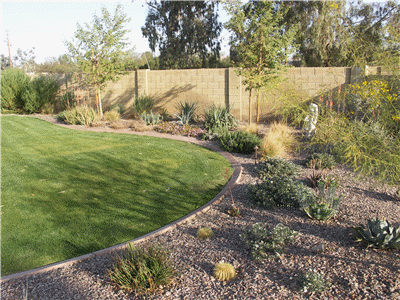Winter Lawn Overseeding

Designed by Tim Bukovszky
Since we live in a desert environment, it is important to use our water as efficiently as possible. Limiting, or forgoing, overseeding is one of many ways to conserve water. There are significant benefits to not overseeding, such as reduced water costs and lower costs associated with preparing and maintaining the winter lawn.
Things to do if you do not overseed
Winter is a great time to work in the yard. If you decide to forgo overseeding this year, you can use the free time for the following garden improvements:
| • | Irrigation schedules. Check for leaks and adjust irrigation schedules for the season. At a minimum, irrigation systems should be adjusted quarterly according to the season. |
| • | Pruning. Winter is a good time to prune some landscape shrubs. Instead of regular shearing, consider an annual selective pruning to produce a more natural-looking plant that will bloom to its full potential. Wait until late February or March to prune bougainvillea, lantana, and other frost-damaged plants. For more information, see the Pruning Schedule. |
| • | Planting. Fall is the perfect time to plant new areas, replace plants that have died or remove high water use plants. Planting in the fall gives roots a chance to establish in the cool months before the hot summer temperatures hit. There are many low water use plants to choose from. Be sure to select a plant that, at maturity, will fit the planting area. This eliminates the need for future shearing to make it fit the spot. |
| • | Weeds. Fall is a great time to get a handle on your weed problem. Application of a pre-emergent herbicide will affect seeds laying dormant in the soil. A post emergent herbicide can be applied directly to weeds that have sprouted. |
Things to do if you do overseed
If you are going to overseed, you can save water by irrigating properly. A well-managed winter lawn can actually use less water than a summer lawn. Before you overseed ask yourself the following questions:
| • | Will the grass area be used? |
Homeowners may decide to forgo overseeding the front yard in lieu of overseeding the back yard where family and pets play.
| • | Is the lawn on a slope? |
Sloped areas are difficult to irrigate without causing run off onto sidewalks and streets. Divide your watering cycles over a period of time during the day so water has a chance to soak into the soil. Be on the look out for over watered areas: soils that are constantly soggy, molds or fungi growing on the surface or yellowing of the grass.
| • | Is the lawn in a narrow strip? |
Efficiently watering strips of grass that are less than eight feet wide can prove to be a challenge. Over spray from sprinklers can hit driveways, sidewalks, streets and cars. You may want to consider removing these strips of grass as part of a long-term renovation project.
Once the rye grass is established and you have mowed it for the first time, it is time to switch your watering schedule. The every day schedule designed to help germinate the seed needs to be changed to irrigating once every 3-10 days. In January your timer should be adjusted again to water every 7-14 days. After a winter rain you can shut off your water for one or two cycles.
Check out the watering guide Landscape Watering by the Numbers for tips on how to water efficiently. An interactive on-line version is available at www.wateruseitwisely.com. Many water conservation offices also offer free landscape and irrigation workshops in the spring and fall.
Jo Miller Water Conservation Program Manager City of Glendale |
Kathleen Moore Water Conservation Coordinator City of Chandler |